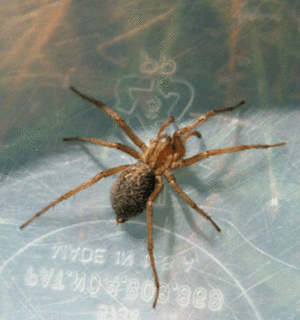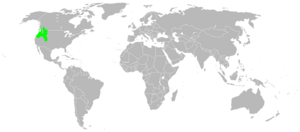Hobo spider facts for kids
The hobo spider (Eratigena agrestis) is a type of spider often called a "funnel web spider." But don't mix it up with the dangerous Australian funnel-web spider! These spiders build webs that look like a funnel. They wait at the narrow end for insects to fall into their trap. Hobo spiders sometimes make their webs near homes. Female hobo spiders lay their eggs in September, and the baby spiders hatch in late spring. After a male hobo spider mates, it dies.
Quick facts for kids Hobo spider |
|
|---|---|
 |
|
| Female hobo spider | |
| Scientific classification | |
 |
|
| Distribution in North America in green | |
| Synonyms | |
|
Contents
About the Hobo Spider's Name
The hobo spider was first described in 1802 by a scientist named Charles Athanase Walckenaer. He called it Aranea agrestis. This name referred to where it lived in Europe: in fields, woods, and under rocks. Later, in 1841, Walckenaer moved the spider to a different group called Tegenaria. In 2013, the Tegenaria group was split up. The hobo spider then moved to a new group called Eratigena. This new name is actually an anagram of Tegenaria.
How to Identify a Hobo Spider
Spiders can look very similar, making them hard to identify. Hobo spiders are usually brownish. Their bodies are about 7 to 14 millimeters long. To be absolutely sure it's a hobo spider, scientists often need to look at tiny parts of the spider's body under a microscope. This is usually done by a spider expert called an arachnologist.
However, you can look for these general features to help tell hobo spiders apart from other similar spiders:
- Hobo spiders do not have colored bands on their leg joints. Many other spiders in the funnel web family do.
- Their abdomen (the back part of their body) often has V-shaped patterns. These V-shapes point towards the spider's head.
- Hobo spiders have a light stripe running down the middle of their sternum (the underside of their body). If a spider has three or four pairs of light spots on the sides of its sternum, it's likely a different type of Eratigena spider. But sometimes these spots are very faint.
- The top of a hobo spider's cephalothorax (head and chest area) usually has blurry or unclear patterns. It does not have two clear dark stripes like some other spiders.
Where Hobo Spiders Live
Eratigena agrestis lives across Europe and into Central Asia. They are also found in western North America. This includes areas like the Pacific Northwest and the Great Basin. They have even been found on a small island in Denmark, likely carried there by trains.
Hobo spiders prefer to live in fields. In Europe, they usually avoid human homes. This is because a larger spider, the giant house spider (Eratigena atrica), often lives in houses there. Hobo spiders build their horizontal, flat, web like a trampoline. They often build these webs near brick walls or wood piles. These spots give the spider shelter while it waits for prey.
Are Hobo Spider Bites Dangerous?
For a long time, people wondered if hobo spider bites were dangerous. However, there is not much proof that hobo spiders are very venomous. In the 1990s, some reports suggested hobo spider bites caused skin damage. But as of 2017, the CDC no longer lists the hobo spider as a venomous species. In Canada, there is no evidence that hobo spider bites cause skin damage. Some bites that were thought to be from hobo spiders might have actually been from other similar spiders.
See also
 In Spanish: Araña vagabunda para niños
In Spanish: Araña vagabunda para niños

